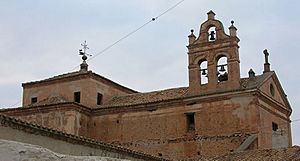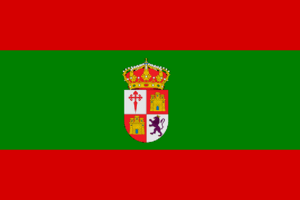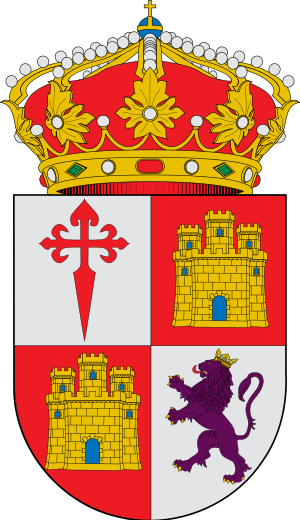Liétor facts for kids
Liétor is a small town in Spain. It's located in the Albacete area, within the region of Castile-La Mancha. Liétor sits in the beautiful valley of the "Mundo" river, in the southeast part of the Iberian Peninsula. In 2016, about 1,279 people lived there. The town also includes several smaller areas like Cañada de Tobarra, Casablanca, El Ginete, Híjar, Mullidar, Talave, and La Alcadima.
One of the most important buildings in Liétor is the Church of Santiago Apóstol.
Contents
A Look at Liétor's Past
Even before the Roman Empire, people lived in small groups along the Mundo river valley. However, the town of Liétor itself didn't exist back then.
Liétor really started during the time of al-Andalus, when Muslims ruled parts of Spain. We don't know the exact year it was founded, but it was likely around the 900s. Important old items found at a place called "Los Infiernos" show that Liétor was a key border town. It was a place where the Muslim lands met the Christian kingdoms. An Arab knight's belongings found there suggest he spent a lot of time fighting to protect or expand these lands.
After the Christian armies took back the area in the early 1200s, King Fernando III gave Liétor to the Order of Santiago. This was a special group of knights. They managed the town until the mid-1800s.
In the late 1400s, some special knights called "caballeros de cuantía" moved to Liétor. Their job was to fight and guard the borders with the nearby Muslim kingdoms. Because of this important work, they didn't have to pay as many taxes as other people.
Amazing Buildings and History
Liétor is known for its beautiful natural setting. It also has three very important old buildings. All of them are considered "Heritage of Cultural Interest" in Spain. This means they are protected because of their historical and artistic value.
Church of Santiago Apóstol
The Church of Santiago Apóstol was officially recognized as a Cultural Interest site on December 22, 1992.
This church is in the main square of Liétor. It was probably built on top of an even older church from the Middle Ages. Only the church tower remains from that earlier time. This square tower was built around the late 1400s or early 1500s. It's a very strong building made of large stone blocks, and it has cool stone gargoyles on its corners.
Inside the church, you'll find the "Espino" chapel. It was built in 1669 by Don Juan de Vandelvira and his wife. This chapel has a large domed ceiling and a big, fancy altarpiece from 1720.
Most of the church was built in the second half of the 1700s. It has a cross shape when you look down from above, with three main sections and chapels. This expansion was needed because the town's population grew, and they needed a bigger church.
The church has many beautiful artworks. The main altarpiece, which looks like the main chapel goes on forever, was made by an Italian artist named Paolo Sistori. There's also a wonderful old organ from 1787. It has a wooden case with fancy Rococo designs. The church also has important statues by famous artists like Francisco Salzillo and Roque López.
Convent and Church of Carmelitas Descalzos
The Convent and Church of the Carmelites became a Cultural Interest site on September 18, 1981.
This old Carmelite convent was founded in 1679 to honor Saint John of the Cross. It was built entirely of brick. In 1835, the monks were forced to leave, and the convent has been empty ever since. Today, the building is used for different cultural events.
The convent church has a cross shape and a dome. The front of the church was built in 1700, as shown by an inscription. Inside, there is a statue of the Virgen del Carmen, which is believed to be made by the artist Francisco Salzillo. The main altarpiece from the church was moved to Murcia in the 1800s, but it was destroyed during the Spanish Civil War.
The convent part was built in 1696. It has paintings that look like bricks on the walls. There's also a crypt (an underground room) that you can visit. It holds the remains of some mummies.
Hermitage of Our Lady of Bethlehem
The Hermitage of Our Lady of Bethlehem was declared a Cultural Interest site on March 5, 1976.
This hermitage (a small chapel) has a very simple rectangular shape. It has wooden ceilings and arches. What makes it special are the amazing paintings that cover almost every wall. These unique folk paintings were made between 1734 and 1735.
Everything inside is painted: altarpieces, curtains, and even fake buildings. The style is simple and colorful, showing a wonderful folk art look. These paintings have a charming, old-fashioned feel and some small imperfections, which make them even more special. The murals show saints, different scenes, decorations, and even a picture of death. Sometimes, they include wise sayings and poems. The front wall has three panels with paintings of the Visitation, the Holy Family, and the Immaculate Conception.
Many other painted altarpieces fill the hermitage. Two important ones are dedicated to San Antonio and Santa Bárbara.
Images for kids
See also
 In Spanish: Liétor para niños
In Spanish: Liétor para niños







